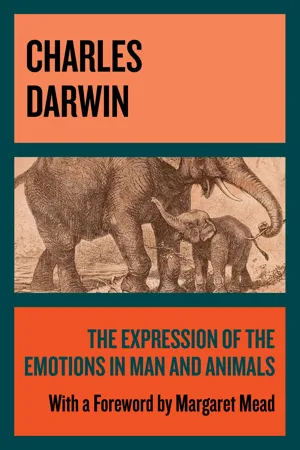
- 372 pages
- English
- ePUB (mobile friendly)
- Available on iOS & Android
The Expression of the Emotions in Man and Animals
About this book
With a foreword by Margaret Mead: Darwin examines genetically determined behavior, combining the science of evolution with insights into human psychology.
Published in 1872, thirteen years after On the Origin of Species, The Expression of the Emotions in Man and Animals is devoted to documenting what Darwin believes is the genetically determined aspects of behavior. Together with The Descent of Man (1871), it sketches out Darwin's main thesis of human origins. Here he traces the animal origins of human characteristics such as pursing of the lips in concentration, tightening of the muscles around the eyes in anger and efforts of memory. Darwin's thesis is that if the outward signs of behavior and emotions are shown to be universal in man and similar to animals then they must be due to inherited evolutionary adaptation, not culturally acquired characteristics. Several British psychiatrists, in particular James Crichton-Browne, were consultants for the book, which forms Darwin's main contribution to psychology. Darwin's collection of detailed observations along with his acute observational abilities and pictures (a landmark in the history of illustrations within the body of the text) corroborate his thesis and form the basis of the book. The foreword by Margaret Mead is of great interest in and of itself. Her foreword, illustrated with pictures provided by her, is designed to subvert Darwin's chief idea. Paul Ekman, a later editor of this same work, "wonder[s] how Darwin would have felt had he known that his book was introduced by a cultural relativist who had included in his book pictures of those most opposed to his theory."
Frequently asked questions
- Essential is ideal for learners and professionals who enjoy exploring a wide range of subjects. Access the Essential Library with 800,000+ trusted titles and best-sellers across business, personal growth, and the humanities. Includes unlimited reading time and Standard Read Aloud voice.
- Complete: Perfect for advanced learners and researchers needing full, unrestricted access. Unlock 1.4M+ books across hundreds of subjects, including academic and specialized titles. The Complete Plan also includes advanced features like Premium Read Aloud and Research Assistant.
Please note we cannot support devices running on iOS 13 and Android 7 or earlier. Learn more about using the app.
Information
Table of contents
- Cover Page
- Title Page
- Foreword
- Introduction
- Chap. I.—General Principles of Expression
- Chap. II.—General Principles of Expression—continued
- Chap. III.—General Principles of Expression—concluded
- Chap. IV.—Means of Expression in Animals
- Chap. V.—Special Expressions of Animals
- Chap. VI.—Special Expressions of Man: Suffering and Weeping
- Chap. VII.—Low Spirits, Anxiety, Grief, Dejection, Despair
- Chap. VIII.—Joy, High Spirits, Love, Tender Feelings, Devotion
- Chap. IX.—Reflection—Meditation—Ill-Temper—Sulkiness—Determination
- Chap. X.—Hatred and Anger
- Chap. XI.—Disdain—Contempt—Disgust—Guilt—Pride, etc.—Helplessness—Patience—Affirmation—and—Negation
- Chap. XII.—Stopbise Astonishment Fear Hobbob
- Chap. XIII.—Self-Attention—Shame—Shyness—Modesty: Blushing
- Chap. XIV.—Concluding Remarks and Summary
- Index
- Copyright Page